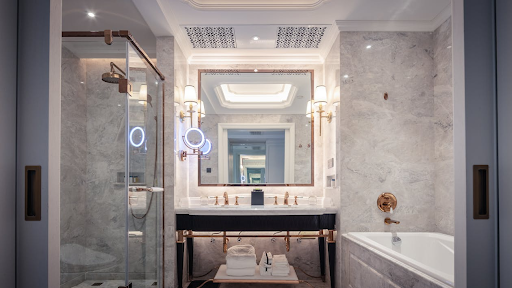Have you ever walked into your bathroom and thought it felt outdated or no longer fit your needs? Whether it’s old tiles, poor lighting, or limited space, many homeowners in Pittsburgh and across the U.S. feel the same. A bathroom remodel is one of the best ways to improve your home’s comfort and value. But starting the process can feel overwhelming. You might not know where to begin, how much to spend, or what the timeline will look like. That’s where this guide comes in handy.
In this blog, we will share what steps to take, what to expect, and how to make your bathroom remodel project a smooth and rewarding experience.
Figuring Out What You Want from the Remodel
Before doing anything else, think about why you want to remodel your bathroom. Are you trying to increase home value, add more storage, or fix old problems? Your goals will shape everything else, from budget to design choices. Maybe you need better lighting, or you’re tired of the outdated tiles.
Next, look at your current space. What works well, and what doesn’t? Consider how many people use the bathroom and at what times. Think about the layout, how easy it is to clean, and what annoys you daily. These observations will help you focus on features that matter most to your family.
Setting a Budget That Works for You
One of the most important parts of planning your remodel is setting a budget. Without one, costs can get out of hand quickly. Start by thinking about how much you want to spend. Then break down the budget into categories like plumbing, tiles, fixtures, labor, and permits. Always leave some wiggle room for surprises, because small issues often come up during construction.
If you’re located in or around Pittsburgh, you’ll find many local companies that offer full-service bathroom remodeling. A reliable Pittsburgh showers company can help you plan your remodel based on your budget and goals. They’ll walk you through choices that balance style and cost. Working with experts also makes it easier to get accurate price estimates and avoid spending more than you planned.
Choosing a Design and Style That Matches Your Home
Now that you have a clear goal and budget, it’s time to think about design. Look at different styles to see what you like. Modern, rustic, classic, and spa-inspired bathrooms are all popular. Consider the rest of your home’s design, so your bathroom doesn’t feel out of place. For example, a modern bathroom might not blend well with a farmhouse-style home.
Pick a color scheme that feels right for you. Light colors can make a small bathroom feel bigger, while darker shades add warmth and coziness. Also, think about materials. Do you prefer tile, marble, or wood finishes? Many websites and showrooms offer visual samples so you can explore options. Creating a mood board with pictures can help you keep your design ideas organized.
Understanding the Timeline and What to Expect During the Process
Remodeling a bathroom usually takes a few weeks, but this depends on the project’s size and complexity. A full renovation that includes moving plumbing or electrical lines will take longer than a simple cosmetic update. After you’ve hired a contractor and finalized the design, they’ll begin by removing the old fixtures and materials. This phase can be noisy and dusty, so prepare your home in advance.
Next comes the construction phase. This includes plumbing, electrical work, and building any new structures like walls or shower stalls. Once that’s done, the team will install tiles, paint the walls, and put in new fixtures. You might not have full use of your bathroom during this time, so plan for temporary solutions. Stay in touch with your contractor to track progress and address any issues quickly.
Selecting Fixtures, Storage, and Lighting
Your bathroom fixtures play a big role in both how the space looks and how it functions. Choose sinks, faucets, toilets, and showers that match your design and meet your needs. For example, a dual-sink vanity might be helpful for a shared bathroom, while a walk-in shower adds comfort and accessibility. Don’t forget about the bathtub—some homeowners prefer to remove it, while others see it as a must-have.
Storage and lighting are just as important. Add shelves, drawers, and cabinets that keep your space organized without feeling cluttered. Choose lighting that works well for tasks like shaving or applying makeup, but also offers a soft glow for relaxing baths. You can layer lighting using ceiling lights, mirrors with built-in LEDs, and sconces. Smart lighting systems can offer extra control and convenience.
Preparing for the Unexpected and Staying Flexible
Even with careful planning, unexpected problems can pop up. Old pipes, mold, or hidden damage might slow down the process or add extra costs. This is why adding a buffer to your budget and timeline is important. Try not to get discouraged if plans shift. Most problems can be fixed with the right team and attitude.
Stay flexible with your choices, too. If a certain tile isn’t available, your contractor can help you find something similar. If a product goes over budget, look for alternatives that still match your vision. Being open to changes can help the project move forward and save you stress. The key is to keep your goals in mind and work closely with your team.
In conclusion, remodeling your bathroom can be a big job, but it’s also one of the most satisfying home upgrades. With the right planning, a clear budget, and a solid team, your dream bathroom is within reach. Start by understanding your needs, and then take it one step at a time. Stay involved in the process, ask questions, and don’t be afraid to adjust along the way. A well-designed bathroom improves not just your home—but your daily life. And that’s something worth working toward.

